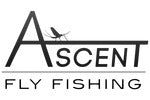
Go-To Fly Patterns for the Mayfly Menu: Part I - Nymphs

The insect order Ephemeroptera, better known to the fly fisher as Mayflies, is one of the most abundant and important food sources for trout across the Northern Hemisphere. The importance of this family through its various life stages is reflected in the thousands of Mayfly patterns available in most shops, which in itself can be a little overwhelming for the fly fishing looking to find a Go-To patterns to stock in their fly boxes. Well, the fly geeks at Ascent Fly Fishing are here to help streamline the Mayfly Menu and share our top fly patterns for each course of the Mayfly meal!
Breaking Down the Mayfly Meal Course by Course - Dry Flies vs Wet Flies

99.9% of the life of mayflies (6-12 months) and 80% of trout feeding on this family happens under the water on early life stage nymphs and emerging nymphs. If we compare this nymph heavy diet to our standard three meals per day, the breakfast and lunch mayfly menu would consist of mayfly nymphs. The very name of this order of insects, Ephemeroptera, means ‘Short Lived’ and refers to the brief, 4 – 48 hours that this family spends as adults (dry flies) on top of the water. For the sake of our menu analogy our emerging mayfly duns, mayfly dun and spinners, and spent mayfly spinner life stages make up the dinner course. To take full advantage of the trout’s nymph heavy diet, your fly box should reflect this with a greater percentage of wet mayfly patterns over dry patterns.
Defining “Go-To Fly Patterns”
There are undoubtedly any number of flies that will work for different mayfly hatches and catch lot fish. The intent of this article is to help the fly fisher simplify fly selection, listing our favorite types of patterns or even a few specific fly patterns that are tried and true producers. In the end, less time guessing = more time catching, so use this article as a foundation for your mayfly box and build off of it for your waters!
Ascent’s Go-To Mayfly Nymph & Emerging Nymph Pattens

A common characteristic of all mayfly nymph patterns (both early life stage on the bottom of the lake or river, and emergers fished higher in the water column) is they ALL are tied with tails, and many also are tied with legs.
Ascent’s Go-To Early Life-Stage Mayfly Nymph Patterns
For the early life stage mayfly nymphs, we like to fish a lot of fly patterns tied to straight shank hooks such as the Flashback Pheasant Tails, Gold Ribbed Hare’s Ears, Prince Nymphs, and Copper Johns. If you add the Juju Baetis to that list, you have a deadly set of early life stage mayfly nymph patterns that can be used to match MULTIPLE HATCHES and HELP YOU CATCH TONS OF FISH!
Ascent’s Go-To Emerging Mayfly Nymph Patterns
The emerging mayfly nymph patterns share many of the same characteristic as those on the bottom of the river (all have tails and some have legs) but these swimming patterns are almost exclusively tied to curved hooks to better match the swimming profile of the emerger and some even add a small wing just starting to peek through the back of the thorax. Change up the sizes and colors to match your specific hatches, but here the short list of Ascent’s Go-To emerging mayfly nymph patterns: the Barr’s Emerger, Greg’s Emerger, Chocolate Thunder, WD-40, and RSII.
The most important meals of the trout’s day are breakfast and lunch, loaded with mayfly nymph and emergers! So, take an inventory, dust off your fly tying vices, or visit Ascent Fly Fishing to let us help you top off your fly boxes with some Go-To mayfly nymph patterns!
May FOM Pattern
Pheasant Tail Nymph
Color: Natural
Size: 18

While there are no secret patterns that are guaranteed to catch fish every time you are on the water, the closest thing to it would be the Pheasant Tail Nymph. This generalist nymph pattern is close enough in color to a host of invertebrate species that - when fished in a number of sizes - can be used to effectively imitate almost any mayfly or stonefly nymph in the water. This traditional tie is done without a flashback or beadhead to provide a light drift and realistic coloration so as not to spook selective trout.
Dry/Wet: Wet
Fly Category: Generalist Pattern
Family: Mayflies, Stoneflies
Species: Blue Quill, Blue Winged Olive, Brown Drake, Brown Dun, Caenidae (Angler's Curse), Grey Drake, Hendrickson, Mahogany Dun, March Brown, Red Quill, Slate Drake, Trico, Western Green Drake, Skwala, Golden Stonefly, Early Brown Stonefly, Chloroperlidae, Winter Black Stoneflies
Life Stage: Nymph


